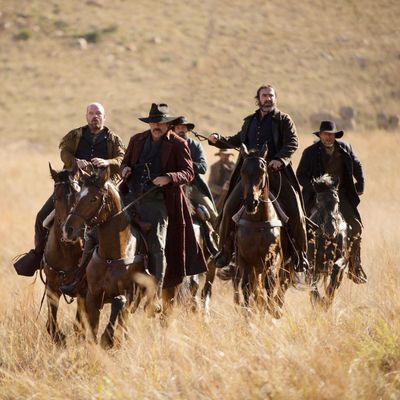
I don’t know when the term revisionist Western came into widespread use, but it’s time we retired it. Even when it meant something, it was a bit of an overstatement; most of the great Westerns bucked convention in one way or another. But starting around the 1960s, it seemed like every entry in the genre pointedly tried to rewrite our collective dream of the West. The unmaking-of-a-myth in The Man Who Shot Liberty Valance, or the heightened violence in The Wild Bunch, or the anti-romance in McCabe & Mrs. Miller, or the ugliness of justice in Unforgiven — they all told us, “It’s not like you thought it was. It’s not what the movies have told you.”
But the movies haven’t been telling us much for some time. And now we’ve finally gone through the looking glass with The Salvation, which is about as conventional and “straight” a Western as can be imagined — the first of its kind I’ve seen since Kevin Costner’s superior Open Range, some 12 years ago. Directed by Danish filmmaker Kristian Levring (who once made the Dogme 95 film The King Is Alive), The Salvation is visually beautiful, morally down and dirty, and simplistic. But it’s marked by two haunted, quiet performances from stars Mads Mikkelsen and Eva Green, who make his otherwise predictable slog worthwhile.
When we first see Jon (Mikkelsen), a Danish settler who has been living in America for years, he’s at a train station anxiously awaiting his wife and son, newly arrived from the motherland. Their brief reunion turns to tragedy when two drunk men rape his wife and slit the boy’s throat. Jon kills both men, and returns home to mourn and bury his dead. Unfortunately, one of the thugs was the brother of local gangster Delarue (Jeffrey Dean Morgan), who extorts protection money from the nearby town and basically has his way with the cowardly citizens. (Now that his brother is out of the picture, he also has his way with his mute sister-in-law Madelaine, a.k.a. the Princess, played by a melancholy Green.) At first, the milquetoast mayor (Jonathan Pryce) and other officials offer up a crippled man and an elderly woman to Delarue as sacrifice. But the monster isn’t satisfied, and when he learns that Jon was responsible for his brother’s death, he comes after our hero.
There’s nothing surprising about The Salvation, which is the most surprising thing about it. Visually sumptuous but dramatically inert, it sticks to a standard, if dusty, template. It all builds up to an inevitable shoot-out in the streets, staged with rote competence but lacking much energy or flair. Frankly, Clint Eastwood did this sort of town-full-of-cowards things way better in his grisly High Plains Drifter (which itself was a dark riff on High Noon) more than four decades ago.
And yet, those actors. Mikkelsen has the most amazing face. I can’t decide if his eyes are unnaturally cold or unnaturally anguished, or if his mouth is fixed in a perpetual state of befuddlement, scorn, or fury. (This is also what made him the most soulful Bond villain of all time.) Here, he makes Jon’s agony and rage palpable, with just the minutest shift; the slow burn becomes unbearable as we watch this man get hounded and hounded, biding his time until the inevitable bloodbath. Meanwhile, Green has a similarly subtle ability to shape-shift emotionally. As the Princess, she’s given little to do and utters not a word, but there’s a familiar glare of outrage in her eyes. We just don’t know for what. Is it vengefulness? Sorrow at the loss of her husband? Her contempt for Delarue? Disgust at what her life has become? Or some combination of all four? There’s agonizing mystery in both these performers’ faces, and they lend The Salvation a depth and tension it otherwise lacks.


